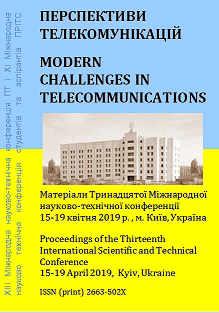ДОСЛІДЖЕННЯ ПЕРЕПУСКНОЇ ЗДАТНОСТІ СИСТЕМ SHDSL EFM У РЕЖИМІ АГРЕГАЦІЇ ПАР КАБЕЛЮ
Ключові слова:
ПЕРЕПУСКНА ЗДАТНОСТЬ, СИСТЕМИ SHDSL EFM, АГРЕГАЦІЯ КАБЕЛЮАнотація
SHDSL EFM systems bandwidth investigation in cable pairs aggregation mode
In modern access networks based on copper cable, EFM is widely used. This technology, using the PAF function, allows you to unevenly distribute data flow between pairs of cables depending on their quality. However, the function of PAF due to the additional fields in data frame leads to decrease the throughput of the transmission system. In addition, there are transitional interference between pairs, which also reduces the throughput of the connection. This report is devoted to researching of impact these two factors on EFM transmission system throughput.
У сучасних мережах доступу, що використовують мідний кабель, є поширеною технологія EFM. Ця технологія використовує протокол PAF, що дозволяє розподіляти потік даних між парми кабелю у залежності від їх якості. Однак, за рахунок використання службових полів знижується перепускна здатність лінії. На додаток, у багатопарному режимі виникають перехрестні завади між парами, що також обмежують перепускну здатність. У цій доповіді наведені результати досліджень впливу цих двох факторів на перепускну спроможність лінії.
Посилання
Стандарт IEEE 802.3, part 3, section 5, clause 61, 2010.
Watson SHDSL EFM Plug-in. Operating manual.: Schmid Telecom, 2014.
ITU-T Recommendation G.991.2, 2003.
В.А. Балашов и др.. Технологии широкополосного доступа xDSL – М.: Эко-Трэндз,2009. 256с.: ил.
Cable reference models for simulating metallic access networks. ETSI STC TM6.
##submission.downloads##
Як цитувати
Номер
Розділ
Ліцензія
Авторське право (c) 2019 Вячеслав Іванович Носков

Ця робота ліцензується відповідно до Creative Commons Attribution 4.0 International License.
Authors who submit to this conference agree to the following terms:a) Authors retain copyright over their work, while allowing the conference to place this unpublished work under a Creative Commons Attribution License, which allows others to freely access, use, and share the work, with an acknowledgement of the work's authorship and its initial presentation at this conference.
b) Authors are able to waive the terms of the CC license and enter into separate, additional contractual arrangements for the non-exclusive distribution and subsequent publication of this work (e.g., publish a revised version in a journal, post it to an institutional repository or publish it in a book), with an acknowledgement of its initial presentation at this conference.
c) In addition, authors are encouraged to post and share their work online (e.g., in institutional repositories or on their website) at any point before and after the conference.

